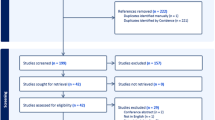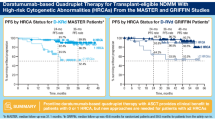Abstract
The use of opioids and/or benzodiazepines in older adults (65 y+) who received an allogeneic hematopoietic cell transplant (HCT) is not known. In March 2016, the CDC released its strongest guidelines against prescription of opioids and co-prescription of opioids + benzodiazepines. We evaluated the use of opioids and/or benzodiazepines in older (65 y + , n = 114) vs. younger (40–64 y, n = 240) allogeneic-HCT recipients before and after the CDC guidelines. The proportion of patients with >10-days of use of opioids and/or benzodiazepines peri-HCT (day-14 to +28) was compared. Opioids: the older (65 + y) group had similar odds of receiving opioids as the younger group (40–64 y) [O.R. 0.7 (95%CI:0.4-1.2)]. Those transplanted after the CDC guideline had 0.4 (95%CI:0.2–0.7) times the odds of receiving opioids. Benzodiazepines: The older (65 + y) group was 0.6 times (95%CI:0.3–0.9) as likely to receive benzodiazepines. There was no significant change in benzodiazepines use after the CDC guideline. Opioids + Benzodiazepines: The older group (65 + y) was 0.5 (95%CI:0.3–0.9) times as likely to receive both opioids+benzodiazepines. There was no significant change in opioids+benzodiazepines use after the CDC guideline. Though we observed a significant decrease in use of opioids after the CDC guideline, the use of benzodiazepines and combined opioids+benzodiazepines remained constant. Older recipients (65 + y) received less opioids, benzodiazepines, and combined opioids+benzodiazepines.
This is a preview of subscription content, access via your institution
Access options
Subscribe to this journal
Receive 12 print issues and online access
$259.00 per year
only $21.58 per issue
Buy this article
- Purchase on Springer Link
- Instant access to full article PDF
Prices may be subject to local taxes which are calculated during checkout



Similar content being viewed by others
Data availability
The data that support the findings of this study are available from the University of Minnesosta BMT Database but restrictions apply to the availability of these data, which were used under approval by the University of Minnesota Institutional Review Board, and so are not publicly available. Data are however available from the authors upon reasonable request and will need permission of the Institutional Review Board.
References
Rhee TG. Coprescribing of benzodiazepines and opioids in older adults: rates, correlates, and national trends. J Gerontol A Biol Sci Med Sci. 2019;74:1910–5. https://doi.org/10.1093/gerona/gly283
CDC NCfHS. Wide-ranging online data for epidemiologic research (WONDER). Atlanta, GA. 2020.
Park TW, Saitz R, Ganoczy D, Ilgen MA, Bohnert AS. Benzodiazepine prescribing patterns and deaths from drug overdose among US veterans receiving opioid analgesics: case-cohort study. BMJ. 2015;350:h2698 https://doi.org/10.1136/bmj.h2698
Dowell D, Haegerich TM, Chou R. CDC Guideline for Prescribing Opioids for Chronic Pain - United States, 2016. MMWR Recomm Rep. 2016;65:1–49. https://doi.org/10.15585/mmwr.rr6501e1
Olin RL, Fretham C, Pasquini MC, Arora M, Bhatt VR, Derman B, et al. Geriatric assessment in older alloHCT recipients: association of functional and cognitive impairment with outcomes. Blood Adv. 2020;4:2810–20. https://doi.org/10.1182/bloodadvances.2020001719
Dowell D, Haegerich TM, Chou R. CDC Guideline for Prescribing Opioids for Chronic Pain–United States, 2016. JAMA 2016;315:1624–45. https://doi.org/10.1001/jama.2016.1464
https://www.fda.gov/news-events/press-announcements/fda-requires-strong-warnings-opioid-analgesics-prescription-opioid-cough-products-and-benzodiazepine. FDA requires strong warnings for opioid analgesics, prescription opioid cough products, and benzodiazepine labeling related to serious risks and death from combined use. August 31st, 2016.
By the 2019 American Geriatrics Society Beers Criteria Update Expert Panel. American Geriatrics Society 2019 Updated AGS Beers Criteria® for Potentially Inappropriate Medication Use in Older Adults. J Am Geriatr Soc 2019;67:674–94. https://doi.org/10.1111/jgs.15767
Pamukcuoglu M, Bhatia S, Weisdorf DJ, DeFor TE, Ustun C, Nayar M, et al. Hematopoietic cell transplant-related toxicities and mortality in frail recipients. Biol Blood Marrow Transpl. 2019;25:2454–60. https://doi.org/10.1016/j.bbmt.2019.07.030
Sorror ML, Maris MB, Storb R, Baron F, Sandmaier BM, Maloney DG, et al. Hematopoietic cell transplantation (HCT)-specific comorbidity index: a new tool for risk assessment before allogeneic HCT. Blood. 2005;106:2912–9. https://doi.org/10.1182/blood-2005-05-2004
Armand P, Kim HT, Logan BR, Wang Z, Alyea EP, Kalaycio ME, et al. Validation and refinement of the Disease Risk Index for allogeneic stem cell transplantation. Blood. 2014;123:3664–71. https://doi.org/10.1182/blood-2014-01-552984
Vadivelu N, Kai AM, Kodumudi V, Sramcik J, Kaye AD. The opioid crisis: a comprehensive overview. Curr Pain Headache Rep. 2018;22:16 https://doi.org/10.1007/s11916-018-0670-z
Maree RD, Marcum ZA, Saghafi E, Weiner DK, Karp JF. A systematic review of opioid and benzodiazepine misuse in older adults. Am J Geriatr Psychiatry. 2016;24:949–63. https://doi.org/10.1016/j.jagp.2016.06.003
Cangemi DJ, Kuo B. Practical perspectives in the treatment of nausea and vomiting. J Clin Gastroenterol. 2019;53:170–8. https://doi.org/10.1097/MCG.0000000000001164
Leslie RA, Shah Y, Thejomayen M, Murphy KM, Robertson HA. The neuropharmacology of emesis: the role of receptors in neuromodulation of nausea and vomiting. Can J Physiol Pharm. 1990;68:279–88. https://doi.org/10.1139/y90-042
Akhtar S, Heng J, Dai F, Schonberger RB, Burg MM. A retrospective observational study of anesthetic induction dosing practices in female elderly surgical patients: are we overdosing older patients? Drugs Aging. 2016;33:737–46.
Lutsky KF, Hozack B, Lucenti L, Kwok M, Beredjiklian P. Post operative opioid, benzodiazepine and sedative usage in medicare versus commercial insurance hand surgery patients. Arch Bone Jt Surg. 2021;9:319–22.
Fredheim OM, Skurtveit S, Loge JH, Sjøgren P, Handal M, Hjellvik V. Prescription of analgesics to long-term survivors of cancer in early adulthood, adolescence, and childhood in Norway: a national cohort study. Pain. 2020;161:1083–91. https://doi.org/10.1097/j.pain.0000000000001800
Agarwal SD, Landon BE. Patterns in outpatient benzodiazepine prescribing in the United States. JAMA Netw Open. 2019;2:e187399 https://doi.org/10.1001/jamanetworkopen.2018.7399
Hofer-Dückelmann C. Gender and polypharmacotherapy in the elderly: a clinical challenge. Handb Exp Pharm. 2012;214:169–82. https://doi.org/10.1007/978-3-642-30726-3_9
Liu CL, Peng LN, Chen YT, Lin MH, Liu LK, Chen LK. Potentially inappropriate prescribing (IP) for elderly medical inpatients in Taiwan: a hospital-based study. Arch Gerontol Geriatr. 2012;55:148–51. https://doi.org/10.1016/j.archger.2011.07.001
Gallagher P, Lang PO, Cherubini A, Topinkova E, Cruz-Jentoft A, Errasquin BM, et al. Prevalence of potentially inappropriate prescribing in an acutely ill population of older patients admitted to six European hospitals. Eur J Clin Pharm. 2011;67:1175–88. https://doi.org/10.1007/s00228-011-1061-0
Cahir C, Fahey T, Teeling M, Teljeur C, Feely J, Bennett K. Potentially inappropriate prescribing and cost outcomes for older people: a national population study. Br J Clin Pharm. 2010;69:543–52. https://doi.org/10.1111/j.1365-2125.2010.03628.x
Brown W. Opioid use in dying patients in hospice and hospital, with and without specialist palliative care team involvement. Eur J Cancer Care (Engl). 2008;17:65–71.
Bengoechea I, Gutiérrez SG, Vrotsou K, Onaindia MJ, Lopez JMQ. Opioid use at the end of life and survival in a Hospital at Home unit. J Palliat Med. 2010;13:1079–83.
Webster BS, Verma SK, Gatchel RJ. Relationship between early opioid prescribing for acute occupational low back pain and disability duration, medical costs, subsequent surgery and late opioid use. Spine. 2007;32:2127–32. https://doi.org/10.1097/BRS.0b013e318145a731
Mahmud MA, Webster BS, Courtney TK, Matz S, Tacci JA, Christiani DC. Clinical management and the duration of disability for work-related low back pain. J Occup Environ Med. 2000;42:1178–87. https://doi.org/10.1097/00043764-200012000-00012
Els C, Jackson TD, Kunyk D, Lappi VG, Sonnenberg B, Hagtvedt R, et al. Adverse events associated with medium- and long-term use of opioids for chronic non-cancer pain: an overview of Cochrane Reviews. Cochrane Database Syst Rev. 2017;10:CD012509 https://doi.org/10.1002/14651858.CD012509.pub2
Acknowledgements
Supported by Marrow on the Move Grant from University of Minnesota.
Author information
Authors and Affiliations
Contributions
DB: Concept and design, integrity of data and accuracy of data analysis; drafting and critical revision of the manuscript. TED: Integrity of data and data analysis; and critical revision of the manuscript. CD, CGB, BT, NEJ, SGH, AR, JR, MA, SB and EW: Integrity of data and accuracy of data analysis, and critical revision of the manuscript. Vidhyalakshmi Ramesh: technical support; acquisition, analysis, and interpretation of data. DJW: Concept and design, integrity of data and accuracy of data analysis; drafting and critical revision of the manuscript.
Corresponding author
Ethics declarations
Competing interests
The authors declare no competing interests.
Additional information
Publisher’s note Springer Nature remains neutral with regard to jurisdictional claims in published maps and institutional affiliations.
Rights and permissions
About this article
Cite this article
Bhargava, D., Drilling, C., DeFor, T.E. et al. Impact of CDC warning on co-prescribing of opioids and benzodiazepines in older allogeneic hematopoietic cell transplant recipients. Bone Marrow Transplant 57, 1079–1085 (2022). https://doi.org/10.1038/s41409-022-01654-1
Received:
Revised:
Accepted:
Published:
Issue Date:
DOI: https://doi.org/10.1038/s41409-022-01654-1



